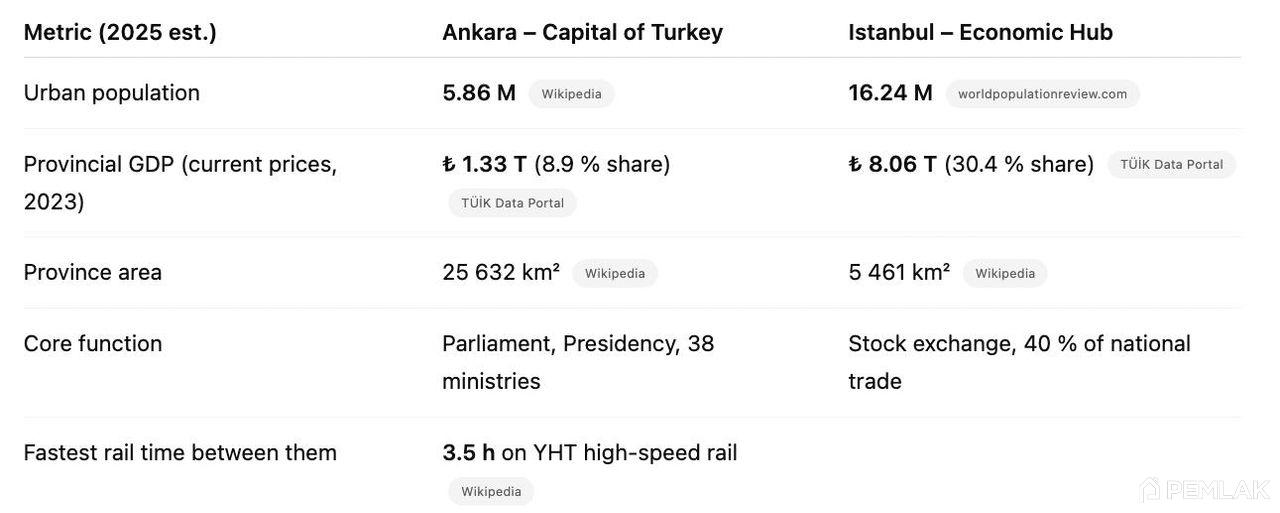Why is the capital of Turkey Ankara and not Istanbul?
Turkey's Capital: From Occupied Istanbul to Temporary Ankara
After World War I, Allied forces occupied Istanbul and dissolved the Ottoman parliament. To keep the nationalist movement out of the reach of foreign gunboats, Mustafa Kemal Atatürk summoned deputies to inland Ankara, where the Grand National Assembly opened on April 23, 1920. Three years later - on October 13, 1923 - Parliament passed a one-sentence law naming Ankara as the seat of government, enabling the proclamation of the Republic of Turkey sixteen days later.
Geography and Defense: Why central Ankara became the capital of Turkey
Located 938 meters above sea level and 450 km from the coastline, Ankara was invulnerable to naval artillery. Existing spurs of the Anatolian Railway allowed troops and cargo to move east, west and south without crossing the Allied-controlled Bosphorus, making the city convenient for defense and logistics.
Building Turkey's modern capital: Ankara as a blank canvas
In 1924, Ankara had a population of only 35,000 and was a "tabula rasa" The master plan for the garden city German architect Hermann Jansen designed in 1932 included wide boulevards, ministerial precincts, and leafy neighborhoods meant to symbolize a secular, forward-looking republic far removed from the Ottoman architecture of the historic Istanbul peninsula.
Turkey's capital today: Ankara vs. Istanbul in numbers (2025)

The table shows that although Istanbul outperforms Ankara economically and demographically, the capital's central location and lower population density still serve the interests of administrative efficiency and national security.
The diplomatic and bureaucratic ecosystem of Turkey's capital city
Within a ten-kilometer radius, Cankaya is home to the president, parliament, 38 line ministries, 123 foreign embassies, and the NATO Ground Command. This dense concentration of institutions shortens the decision-making cycle and makes Ankara one of the largest diplomatic clusters in the world - surprising for a city that a century ago was a provincial market town.
Transportation links connecting the Turkish capital with Istanbul
Twelve YHT flights a day traverse the 530-kilometer Ankara-Istanbul corridor in 3.5 hours, and the planned 350 km/h "super-HST" should reduce this to ≈80 minutes this decade.
Esenboga International Airport will serve more than 12 million passengers in 2024 and rise in the Skytrax world rankings.
Culture and identity of Turkey's capital city
Ankara is not just about ministries and marble. At the Museum of Anatolian Civilizations, Hittite relics can be seen beneath a restored Ottoman caravanserai. The citadel quarter with its winding streets and craft shops predates Rome. Anıtkabir, Atatürk's mausoleum, receives about five million visitors a year and is the foundation of the city's civic identity.
Myths about Turkey's capital city - debunking them
Myth: "Ankara was chosen only as a symbolic gesture"
Reality: Security came first and symbolism came second. Allied guns could not reach the plateau.
Myth: "Now that everything is stable in Turkey, the capital should return to Istanbul"
Reality: Separate political and commercial poles reduce congestion and balance regional power, like Washington versus New York or Canberra versus Sydney.
Why Ankara remains the logical capital of Turkey
The choice of Ankara in 1923 combined wartime pragmatism with a visionary urban plan. A century later, its favorable geography, central location, concentration of institutions and modern connectivity still justify keeping the capital on the Anatolian plateau, while Istanbul continues to shine as Turkey's unrivaled cultural and financial titan.
Comments 0







